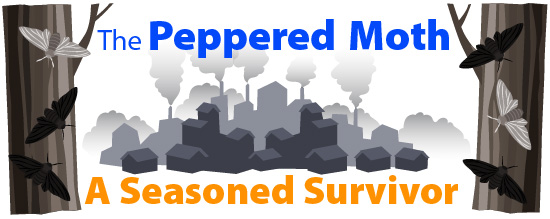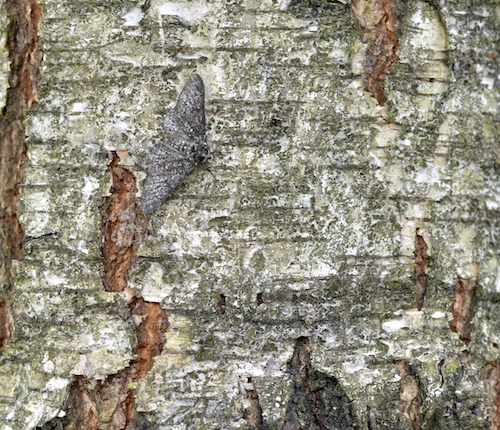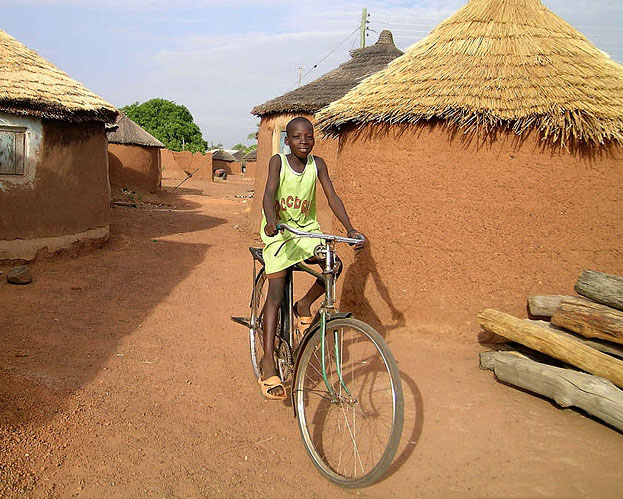Wings in a New Light
The peppered moth lands on the bark of a tree trunk and opens its wings to rest. A hungry flycatcher bird that was close behind swoops down for a meal but loses sight of its prey. The moth blended in with the tree trunk. Blending in let it avoid the pesky flycatcher, so the moth lives to see another day. This may seem like a simple act of nature, but scientists are quite curious about how and why these sorts of interactions arise.
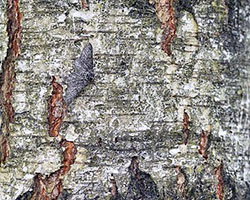
The peppered moth's cryptic wing color is based on several different factors. How did an individual moth end up with that wing color? And why does this species of moth even have those wing colors?
The How and the Why
Scientists ask these sorts of questions and test them based on previous knowledge and future predictions. Some common questions focus on how a trait develops. This is known as the proximate cause. The proximate cause of the wing color in the peppered moth is genetic. A specific gene codes for whether they have light or dark-colored wings. In moths that survive and reproduce, the genes for a specific color is passed to their offspring.
Now, let’s look at the bigger picture. Why might an animal like the peppered moth have colored wings? Why a trait evolves is known as the ultimate cause. We now know that the wings of the peppered moth help the moths blend in. By blending in, their chances of survival increase. So in a specific environment, one wing color may help more moths survive than the other wing color. That's a pretty important benefit. The proximate cause and ultimate cause are often both involved in bringing about a trait that helps an organism survive in its niche.
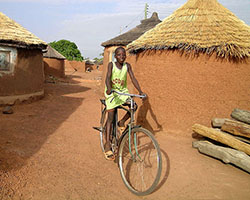
Understanding both the proximate and ultimate causes helps us to understand why traits change over time. In non-polluted forests, moths with light wings were more likely to survive. In polluted forests, moths with dark wings blended in better. They were less likely to get eaten by birds and could then reproduce and pass their wing colors on.
We can also look at more familiar problems in terms of proximate or ultimate questions. Think of a bicycle. To go forward, you move the pedals. This turns the wheels, moving the bike. That is the proximate cause of how a bike works.
But what are the ultimate causes of why the bike moves? One proposal is that humans needed a faster way to get around. We designed the bike to help us move around faster and use our time more wisely.
If you're still confused about proximate vs. ultimate, try to think of it in a different way. Proximate and ultimate explanations also differ in the time scale over which they act. Proximate explanations focus on things that occur during the life of an individual. Ultimate explanations focus on things that occur in populations over many generations. Think you have a handle on the how and the why of biology?

Test Yourself
Try to come up with a few proximate and ultimate questions for the following adaptations: Moth color, group food searching in birds, parenting in mammals, and crying babies.
In bold are our categories and examples of our main questions. Some subquestions have also been included.
| ADAPTATION | PROXIMATE QUESTIONS | ULTIMATE QUESTIONS |
| Moth color |
How is wing color caused? -Is wing color genetic? -Were the different moth colors caused by DNA mutations? -Does the environment determine moth color? |
Why is one color more common? -What behaviors or environmental factors determine which wing color is more common? -Does selection of mates influence wing color? -Is wing color only helpful due to camouflage? |
| Group food search |
How are the birds finding food in groups? -Are birds signaling each other? -Which senses do they use to find food? |
Why is it beneficial to search for food in groups? -Is looking for food in groups safer? |
| Parenting in mammals |
How do animals know to take care of their young? -Do they learn it from parents? -Are they born knowing how? -Do hormones cause the behavior? |
Why are some animals good parents? -Does having good parents increase survival? -Do animals with good parents reproduce more? |
| Crying babies |
How do babies decide when to cry? -Is there a trigger that makes a baby cry? |
Why do babies cry? -Do mothers pay more attention to crying babies? |
Now try to figure out the answers to some of the questions you asked for those same adaptations.
| ADAPTATION | PROXIMATE CAUSE | ULTIMATE CAUSE |
| Moth color |
A specific gene codes for black wing color and a specific gene codes for white wing color. The black color first showed up as a genetic mutation. |
These moth wing colors evolved because mutations that helped the moth blend in and survive were passed on to the next generation. |
| Group food search | Birds use vision to find patches of food and groups of the same species. | Group foraging evolved to allow more time to forage while others detect predators. The more birds in a group, the less chance they have of being eaten by a predator. |
| Parenting in mammals | The release of the oxytocin hormone triggers a parenting instinct in mothers and some fathers. | Good parenting increases survival of young. Young can then grow up and reproduce, passing on their genes. |
| Crying babies | Specific triggers, like a wet diaper, makes the baby cry. | Human babies evolved to cry in order to alert the parents of a specific need. |
Tying It All Together
Both types of causation are interesting on their own. But realize that they are connected. We must study nature using both types of questions. This helps us to understand how traits evolve and benefit organisms.
Additional images via Wikimedia Commons. Elephant beetle by Derek Ramsey.
Read more about: The Peppered Moth: A Seasoned Survivor
Bibliographic details:
- Article: Why vs. How in Biology
- Author(s): Dr. Biology
- Publisher: Arizona State University School of Life Sciences Ask A Biologist
- Site name: ASU - Ask A Biologist
- Date published: 5 Aug, 2015
- Date accessed: 21 May, 2025
- Link: https://askabiologist.asu.edu/why-vs-how-biology
APA Style
Dr. Biology. (Wed, 08/05/2015 - 15:46). Why vs. How in Biology. ASU - Ask A Biologist. Retrieved from https://askabiologist.asu.edu/why-vs-how-biology
Chicago Manual of Style
Dr. Biology. "Why vs. How in Biology". ASU - Ask A Biologist. 05 Aug 2015. https://askabiologist.asu.edu/why-vs-how-biology
MLA 2017 Style
Dr. Biology. "Why vs. How in Biology". ASU - Ask A Biologist. 05 Aug 2015. ASU - Ask A Biologist, Web. https://askabiologist.asu.edu/why-vs-how-biology

Using proximate and ultimate questions help in the study of traits or behaviors of organisms. How and why might horns like this develop in an elephant beetle?
Be Part of
Ask A Biologist
By volunteering, or simply sending us feedback on the site. Scientists, teachers, writers, illustrators, and translators are all important to the program. If you are interested in helping with the website we have a Volunteers page to get the process started.



